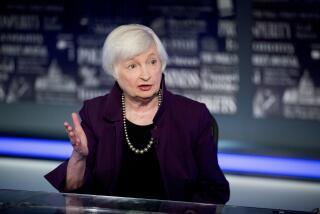Market Watch : ‘Nerds’ at Rating Agencies Are Wall Street Prophets : Bonds: Doormats in the ‘80s, firms like Standard & Poor’s gain new importance. Junk bonds, it seems, really were junk.
- Share via
NEW YORK — When Drexel Burnham Lambert Inc. went down the drain three months ago in the biggest bankruptcy in Wall Street’s history, it was Jeffrey Bowman who pulled the plug.
Bowman toils here as an unsung numbers cruncher at Standard & Poor’s Corp. Bowman’s task is telling investors whether Drexel or other brokerage, his specialty, are likely to make their payments on bonds and other borrowings on time.
In November, after poring over balance sheets and making a host of obscure financial calculations, Bowman concluded that Drexel’s financial condition was deteriorating. In particular, it was suffering from a plunge in the value of its junk bond portfolio.
After several meetings with Drexel management, Bowman acted. He lowered his rating on Drexel’s commercial paper, or short-term corporate IOUs, to A-3 from A-2. That meant Standard & Poor’s thought that Drexel had slipped a notch closer to default on those debts.
The result was quick and dramatic. Within weeks, Drexel faced a severe cash squeeze as banks and other investors responded to the downgrading by refusing to renew about $400 million in loans to the firm. In February, after unsuccessfully seeking a new source of financing, Drexel defaulted on $100 million of commercial paper and filed for bankruptcy.
Bowman was a prophet who told the world of Drexel’s impending downfall. He wasn’t the direct cause of it. But his action marked a critical turning point for the firm, and its impact illustrates the growing influence that the ratings agencies wield at a time of widespread jitters among investors about rising numbers of defaults and bankruptcies.
While the financial markets have always paid attention to debt ratings, the focus intensifies at times, such as now, when credit is scarce and financial resources are stretched.
“We’re in the limelight right now. Wall Street operates between the boundaries of greed and fear, and today it’s closer to the fear side of the equation,” said Leo C. O’Neill, president of Standard & Poor’s Ratings Group. (Another branch of Standard & Poor’s created the well-known S&P; 500 stock index.)
Ratings firms are the judges responsible for telling the public whether a bond is safe or speculative, “investment grade” or “junk.” They also decide whether a bond is extremely safe, rated AAA, or merely a pretty good investment--say, A or BBB.
These fine distinctions can mean a difference of millions of dollars in borrowing costs for companies, as well as for city, state and national governments.
A downgrade of New York state’s debt last month is expected to cost the state at least $40 million in extra interest the next time it taps the bond market.
Even a small change in the debt rating by Standard & Poor’s or Moody’s Investors Service, the two biggest and best-known firms, can cause havoc for a bank or other financial company that relies on borrowing to stay afloat.
Late last month, a downgrade of Citicorp, the nation’s largest bank holding company, triggered a slump in stock prices for the entire banking industry. Financial services giant American Express Co. has pumped more than $1 billion since December into its troubled brokerage subsidiary, Shearson Lehman Hutton Inc., largely to prop up its credit rating.
In some cases, as with Drexel, a downgrade has contributed to a company’s collapse. Mortgage & Realty Trust, a real estate investment trust, found itself cut off from bank credit in March within 24 hours of a lowering of its debt rating. It filed for bankruptcy protection on April 12.
The ratings firms’ new-found power marks a turnaround that might be termed the “revenge of the nerds.” In the heady 1980s, Drexel and other advocates of junk bonds disdained what they viewed as the raters’ excessive caution over the high-yield but risky securities.
In those days, the high fliers would sniff that ratings analysts were “badly dressed and poorly paid and could not be counted on to do what markets do, which is look ahead,” a Wall Street bond specialist said.
Today, however, with the junk bond market is in a severe slump and Drexel in bankruptcy court, the raters are basking in the glow of regained respect.
“The (ratings) agencies were right after all. . . . They recognized junk for what it was,” said Richard Lehmann, president of the Bond Investors Assn. and a frequent critic of the ratings agencies.
O’Neill of Standard & Poor’s said: “I feel that in some respects we were vindicated, because the true risk of junk bonds certainly has become apparent.”
But the glare of public interest has drawn renewed attention to longstanding complaints that the ratings agencies are too slow in adjusting their ratings to reflect changing market conditions, or are not sufficiently precise in judging the quality of some securities, especially junk bonds.
“Many times you’ll find that a company’s bond rating is changed two or three times in the six months before it goes bankrupt. Obviously, that’s not very much time for the market to react,” said Edward I. Altman, a finance professor at New York University.
But Altman said the agencies do a good job overall.
“The rating agencies have really been under pressure to be on top of the markets. When they miss one out of 500, they draw criticism,” said Paul H. Ross, a managing director and veteran bond researcher at Salomon Bros.
Fueling the controversy is a major push by one of the smaller ratings firms, Fitch Investors Service Inc., to capture business by seeking to move more quickly to adjust ratings for changing conditions and to explain its rationale more fully than its competitors.
Fitch, which has lured away a considerable amount of talent from Standard & Poor’s, has more than tripled in size to 143 employees since a new, more aggressive management acquired it 13 months ago. That still leaves it much smaller than Standard & Poor’s, which has about 600 employees in its ratings service worldwide, and Moody’s, which has 1,100, including those in its printing facility.
In deciding how safe a bond or other borrowing is, the ratings agencies judge the size of the margin of safety that the debtor enjoys in case the economic environment turns sour and it becomes difficult to make payments.
The agencies normally are paid for their work by the corporation or other entity that issues the bonds. The issuer is willing to pay because it knows that many potential investors will buy only rated securities.
Some observers believe that the combination of intense concern over credit safety and extra competition in the ratings business itself has led the agencies to be more rigorous than ever in evaluating securities.
“There seems to be a contest now to see who can be more aggressive in downgrading people,” said Lehmann, who edits the Defaulted Bonds Newsletter in addition to heading the Bond Investors Assn. The association is a nonprofit information organization based in Miami Lakes, Fla.
Figures from the ratings agencies show that there has been a sharp increase in downgrades. In the first three months of this year, Moody’s downgraded ratings of 95 corporations affecting about $75 billion of long-term debt. It raised the ratings of only 23 issuers, affecting $26 billion of debt.
In a sign that the situation was worsening, Moody’s noted that the ratio of downgrades to upgrades for that period was steeper than the average of 2 1/2 downgrades per upgrade for all of 1989, when the number of actual defaults reached a 20-year high.
Lehmann said the agencies had turned more cautious in part because of several “very spectacular bond collapses” in recent months. These included the bonds of heavily indebted retailing giant Campeau Corp., owner of Bloomingdale’s, and the Drexel-financed firm Integrated Resources Inc.
But the ratings agencies insist that they are careful to apply consistent standards in good times and bad. They say the increased number of downgrades merely reflects the worsened financial situation of many companies that took on too much debt in the past decade.
“You had a great degree of leveraging of the corporate sector in the late 1980s, and that process to some degree is reversing itself. People focus in on the ratings because they’re highlighting some of the strains that have come out of that period,” said Tom McGuire, executive vice president and director of corporate ratings for Moody’s.
The agencies are proud of the fact that only one company, Manville Corp., has defaulted on bonds that were rated investment-grade at the time. In that case, in 1982, the building materials company was hit suddenly by massive legal liabilities related to cancer-causing asbestos products.
They also point to studies that show a clear relationship over time between bonds’ ratings and the frequency of default. Between 1970 and 1989, for example, Moody’s calculates that the average default rate in the first 10 years of life of bonds initially rated as investment grade was 2.2%, compared to 18.1% for those initially rated as speculative or “junk.”
More to Read
Inside the business of entertainment
The Wide Shot brings you news, analysis and insights on everything from streaming wars to production — and what it all means for the future.
You may occasionally receive promotional content from the Los Angeles Times.










